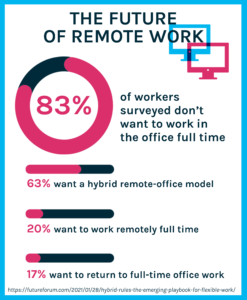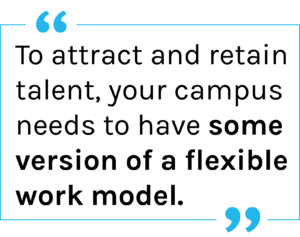The future of the HigherEd workplace embraces flexibility.
The last two years have brought a great deal of change to the world of HigherEd. Campuses that were the center of activity were nearly empty for months, and even with students, faculty, and staff back on campus, norms have shifted—both across the U.S. and for higher education specifically. In 2022, how can you prepare your campus for a future with hybrid work and learning—and why should you? Read on to learn more.
The War for Talent
In much of the corporate and tech world, it’s been accepted that there is a new model of work. Major companies have committed to flexible or hybrid work models, offering both remote options and open office settings for their employees. According to Slack’s Future Forum, 83% of workers surveyed don’t want to work in an office full time. The survey found that “63% favor the flexibility of a hybrid remote-office model, while 20% want to work remotely full-time. Only 17% want to return to full-time office work.” These statistics, along with the corporate world’s acceptance of a new normal, put the pressure on higher education institutions. In order for colleges and universities to be competitive employers, retain faculty and staff, and win the war for talent in 2022 and beyond, they’ll have to embrace the idea of a flexible office.
Benefits for the whole campus
Leaders should also think about the potential benefits that a hybrid campus work environment can bring for talent management and beyond. Not only will a flexible model appeal to a larger variety of applicants, but it allows a hiring committee to expand its search outside the traditional geographic bounds of the community, broadening the candidate pool.
There can also be potential cost savings involved for colleges and universities who build remote work policies wisely. According to a survey by EAB, institutional leaders expect an increase in remote and hybrid work in specific departments that are conducive to such flexibility, including HR, Legal, Finance, and IT. This could bring down overall costs by decreasing the need for office space and parking.
A hybrid model also means that colleges and universities can focus their resources more heavily on the people and functions that are best to have face-to-face, while making other functions more effective or efficient with remote models or through outsourcing. Harvard Business Review notes that “the hybrid campus offers opportunities to improve the speed and quality of services that don’t always require face-to-face interaction, such as virtual advising and online office hours with professors,” and in the same article, encourages HigherEd leaders to think about what “other services could potentially be better delivered by external entities that can invest in those services and provide them at scale… like online student mental health therapy and telemedicine services.” Consider the benefits to students of counseling and advising services being available remotely. Remote options can increase access to such services for part-time students, commuter students, or students with overloaded schedules, potentially positively impacting student outcomes.
How do we make it happen?
To attract and retain talent, your campus needs to have some version of a flexible work model. The key to making this work—and work well— is digitization. Just as successful remote learning was dependent on getting the right tools and platforms in place, it’s important to reimagine workflows and processes to ensure productivity when not everyone is in the office.
is digitization. Just as successful remote learning was dependent on getting the right tools and platforms in place, it’s important to reimagine workflows and processes to ensure productivity when not everyone is in the office.
As Inside HigherEd notes, “academic institutions…have an opportunity to breathe new life into campus culture by embracing new, digital-first channels. Digital platforms now allow individuals, teams and organizations to maintain alignment regardless of where or when they are working.” Migrating all data to digital platforms, embracing online project management tools, and shifting HR processes to a centralized system—like PeopleAdmin’s HigherEd Platform–are all vital steps for higher education institutions to take if they want to succeed in a hybrid setting. In fact, teams can take the opportunity not to just digitize their workflows and best practices, but to re-evaluate them. Leaders should ask what’s working and what could be improved.
Many managers are concerned that productivity might take a hit with a hybrid work environment, or that it will be difficult to keep employees engaged and working as a team. The Chronicle of Higher Education, in a piece about best practices for remote work, noted that trust was vital to making a remote management relationship work, but also that managers may need to re-frame the way they think about work. It can be helpful to build expectations around results instead of process. Ask what final product someone is producing, and does it work, rather than whether they were at their desk or at home. Even with these best practices, it’s important that managers also have the right tools to support and monitor their teams.
Digitizing your performance management process is an important step in the right direction. A platform like PeopleAdmin’s Performance Management, which now utilizes the 9-box potential management tool, allows for collaboration between HR and managers and empowers succession planning, all in one place.

Final thoughts
As your institution dives headfirst into the challenges of 2022, it’s a good time to examine your vision for the future of hybrid work. What are the benefits and drawbacks? How do your current employees feel? If you’re moving forward with flexible work, ensure that you have the right tools in place so that your teams can be successful from top to bottom.